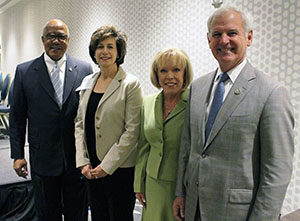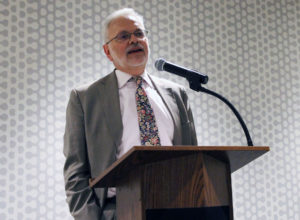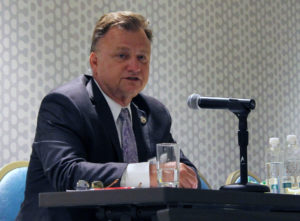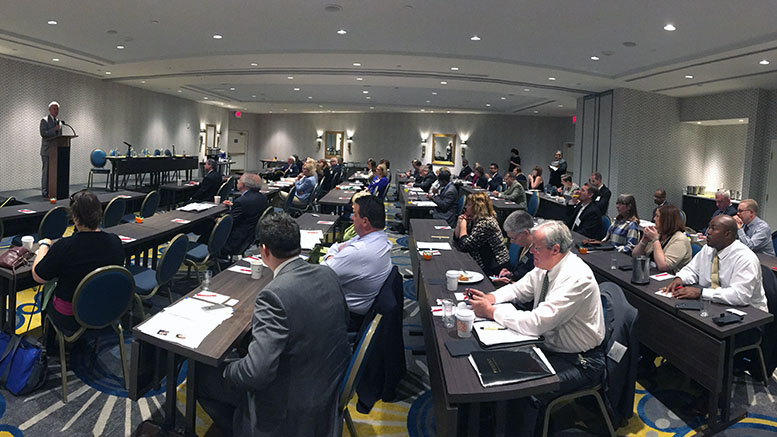As President Donald Trump this week outlines his training-to-jobs plan, the proposal is only a part of the effort to help Americans attain the education and training needed for good-paying careers. The second part is crafting the legislation and aligning funding to make it happen.
“We have to pick up after the roll out and make it happen,” said Rep. Bradley Byrne (R-Alabama), who spoke Tuesday at the American Association of Community Colleges’ Advocates in Action meeting.
Byrne, who serves on the House Education and the Workforce Committee and is a former chancellor of the Alabama Community College System, said current funding for career and technical education (CTE) is not enough for these programs, which are proven to work. When asked how Trump’s verbal support of CTE and job training seems to misalign with his recommendations to cut those programs, Byrne noted that the president’s budget proposal is more of an “aspiration document” and that Congress sets the appropriation bills to fund programs.

(From left) AACC President Walter Bumphus; Mary Graham, AACC board chair and president of Mississippi Gulf Coast Community College; Vicky Karolewics, AACC board member and president of Wallace State Community College; and Rep. Bradley Byrne (R-Alabama).
Byrne said there is room for reform and trimming overall federal spending — he called the U.S. Education Department “too top heavy” — but it should be done with purpose.
“Let’s use a scalpel and not a butcher knife,” he said.
The congressman said he would like to see a larger proportion of federal funding go toward programs like CTE at the local level. CTE programs should appeal to all lawmakers because they help lift individuals out of poverty by providing them with a skill to earn a living and, as a result, reduce people’s reliance on federal assistance.
“It’s taking full advantage of the human capital, which we’re not doing,” said Byrne, noting that other countries such as Singapore are better at leveraging training and developing their workforce than the U.S.
Byrne touted that community colleges are a “tremendous resource” to turn the tide. Every community college should invite their congressional representatives and other stakeholders to graduation to see firsthand how earning a credential from a two-year college not only affects graduating students, but their families as well.
“You’re where the rubber hits the road,” he said at the meeting.
A pundit’s POV
Economist David Wessell agreed that community colleges are positioned to help train U.S. workers to compete in a global economy.
“There are compelling stories of people making $8 and $10 hour – or who lost low-paying jobs – who went to a community college and are now making $20 an hour,” said Wessell, director of the Hutchins Center on Fiscal and Monetary Policy at The Brookings Institution and a contributing correspondent to the Wall Street Journal.

Economist David Wessell offers his views on the president’s priorities and proposals.
But that widespread support doesn’t mean community colleges should expect a big funding increase from the federal government, Wessell said. The president’s budget priorities include large increases in defense spending and tax cuts – which would be offset by huge cuts in discretionary programs, including workforce and education programs.
Although Congress isn’t likely to pass everything in the Trump budget proposal, he said, “All the things you care about are going to get squeezed.”
Regarding student loans, it’s not clear what will happen, but “we need to be sure that whatever they do on this isn’t a regressive solution,” Wessell said.
There is a feeling in Washington that student loans are in crisis, but most of the attention is on graduates with advanced degrees who are $75,000 in debt. Members of Congress can’t seem to grasp that those with the highest default rates are people who owe less than $5,000, but can’t repay their loans because they didn’t graduate and ended up in low-wage jobs.
Legislative priorities
An administration official and a panel of congressional professionals also spoke during the Advocates in Action meeting.
Byron Zuidema, acting assistant secretary at the U.S. Labor Department, said the departments of Labor and Education “have a shared mission when it comes to community colleges.”
That joint partnership has been fueled by the $2 billion Trade Adjustment Assistance Community College and Career Training (TAACCCT) grant program, Zuidema said, although new funding for that program isn’t expected.
“That $2 billion was well invested,” he said, noting that the TAACCCT investment has yielded several important shifts, including the value of short-term training and the ability to change course rapidly to meet employer needs.

Acting Assistant Labor Secretary Byron Zuidema comments on lessons learned from the federal TAACCCT program.
While graduation rates are important, what really matters is the goal of the learner and whether he or she achieve it, Zuidema said. And that doesn’t always mean a four-year or even a two-year degree, as accredited certificate and apprenticeship programs in partnership with employers provide good alternatives, he said.
A bipartisan panel of congressional staff involved in higher education issues outlined some of the key legislative priorities in Congress: reauthorizing the Higher Education Act and the Carl D. Perkins Act, expanding the Pell Grant program to cover short-term training, college affordability, and simplifying the student aid process.
One major AACC legislative priority has already been enacted – year-round Pell funding. AACC President Walter Bumphus called that “the most important achievement we’ve had in years.”
For more photos from the AACC Advocates in Action meeting, visit the AACC Facebook page.

